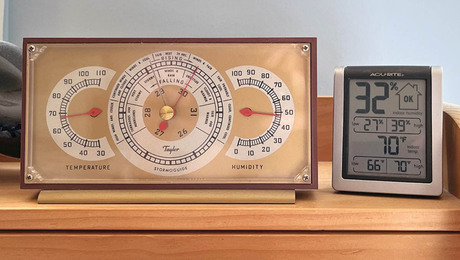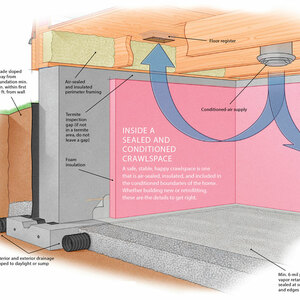I have a site with a 24″ retaining wall that has a drain system behind it consisting of a 6″ preforated pipe in a geosock embedded in a 24″ base of gravel that drains into a sump pit. The preforations on the pipe are facing down.
Lots of water is seeping up under the wall and not much was draining out of the 6″ pipe into the pit. in fact, more water is seeping into the pit through seams in the enclosure wall than is coming in through the pipe.
There’s a tree next to the line between the wall and the pit, so I figured there were lots of roots. We camera’d the line and sure enough, it had roots in the vacinity of the tree.
We rootered the line and then sent a corbin through and camera’d it a second time. The line is nice and clear now, but you still see stubble of roots filling a lot of the drain holes and not a whole lot more water is coming out of the pipe. We’re pulling the tree out so it won’t keep clogging the pipe, but is the drain line a lost cause? Am I going to have to dig up the pipe and rock and replace the whole thing?
Groundwater is rare here in Southern California and we don’t have a lot of experience in this stuff, so please stifle the snickers…
Thanks


















Replies
The holes should have been facing up so that the pipe will hold/carry the water to it's intended discharge point.
Not true.
The holes (if located on one side of pipe) should face down so that the rising water table flows into the pipe . Most drain pipe used for this purpose have several rows of inlets or are perfed all the way around.
My guess is that the filter wrap is plugged with very fine sediment.
What the soil type at Your laocation can make a big difference.
It is also possible that the bottom of the wall is below the level of the pipe.. Water will always take the easiest path.
I have seen gophers dig a tunnel under a drain pipe and wall and all the water flows out of their hole. Now just how do cylindrical objects have sides anyway ??
Might be regional differences, but from what I've seen and experienced in the northeast, the partialy perforated drain pipe behind a retaining wall allows the surface water a place to collect and be carried away. It enters from the top of the pipe, which is where the holes should be. It's purpose isn't to control high water tables...different animal. It's to control hydraulic pressure from blowing out the wall. The fully perforated pipe is usually used(around here) for curtain drains. I do agree with the other points you mention and they could also contribute to the problem. The OP said ground water wasn't an issue, so I assume this is from excessive surface runoff...CA gets some serious monsoons at times.
Nope. Holes on bottom. He has it buried in gravel and if the holes were on top it would only carry away the water that had risen to the top of the pipe leaving a 4" deep pool of water to be absorbed by the already saturated soil.
If you put the holes on top and you want the tile to effeciently carry all the water away, you must find a way to channel all the water directly to the holes. Any water that didn't fall into the holes would run into the soil next to the tile.
Don't think of drain tile as a pipe that isn't supposed to allow any water to spill out. Think of it as a tunnel thru the soil to open air or a drain pit.SamT
Anyone who doesn't take truth seriously in small matters cannot be trusted in large ones either. [Einstein] Tks, BossHogg.
Interesting to say the least. Let me get back to you on this one. I'd like to pay a visit to someone who builds retaing walls. He puts the holes facing up and told me if they are facing down, it is no different than just using gravel without the pipe. I use to think the way you and dove explained it was correct, until I saw several different walls being built, including one comercial job that the wall was about 30' high.
One thing that does have to happen is that the pipe has to be laying on a thin gravel bed and be surrounded by gravel. Sam's description of how it works is correct.
Wouldn't be the first time the "Pro's" on constrution sites did things wrong. Next time ask them just how they intend the water to find it's way into the holes.
No doubt, I'll be sure to ask.
I stand corrected, at least based on a simple search...."Perforations in smooth wall drain pipe and coextruded dual wall corrugated pipe are small diameter holes located in rows on one side of the pipe which should always face downward to prevent soil from infiltrating the pipe." Copied from http://www.capbrick.com/drain_data.htmI know what I saw and what I was told, so next step is to see what this guy who told me has to say. The only question I still have Sam is would its still matter if the whole drain bed is wrapped in fabric? IIRC, the comercial job had some type of fabric laid out, then a bed of clean stone, next the solid pipe with downfacing holes, another layer of clean stone and then all wrapped up like a Tortia.
Shouldn't matter IMO. The fabric is to keep "fines" and dirt put of the pipe, yet allow passage of water.
In my experience it doesn't always work real well. I have dug up drains wrapped in filter fabric that were laying in a gravel filled trench with standing water. The fabric had actually become plugged from the fine clay we have here. Water was getting through , but at a very reduced rate.
Sam knows more than I do about filter fabric though.
Sam knows more than I do about filter fabric though.
I wish!
I use the stuff on the basis that it is going to clog with fines and try to use as large an area as possible.
This last job, my FFILs' place, I put the fabric between the gravel and the soil and used a gravel bed that ran from footing to grade. I turned the fabric over the gravel about 2" from the top and laid a decorative layer of gravel over the the last flap of fabric.SamT
Anyone who doesn't take truth seriously in small matters cannot be trusted in large ones either. [Einstein] Tks, BossHogg.
Sorry guys, I should have given more information.
The drain system was designed and the plans stamped by a civil engineer, and it was inspected by a private inspector to be installed according to plans. The soil is decomposed granite, which is why the water; the base of the retaining wall is practically bedrock, and the hillside above it is DG. I believe the pipe is below the base of the retaining wall.
What I am wondering is if the system has been irrepariably compromised by the roots that grew into the gravel and are probably surrounding the pipe. One root that had gotten into the pipe was about 1" in diameter. I really do need the system to work optimally, as I'm putting a modular building on a pad at the base of the retaining wall.
By the way, we do have drain systems that consist of gravel wrapped in geofabric and pipes that penetrate the retaining wall from it- we call them burrito drains. I saw my last one at the bottom of a twelve foot retaining wall.
Thanks again guys for all your help.
FWIW..
I doubt the drain pipe has been seriously compromised . You now have it open so it should work.
The tree roots also provide a drain way for water thru the soil so that alone should not be causing any problems either.
Without knowing more I can't say anything for sure but given the soils composition isn't it possible that a root may have penetrated deep enough to allow a drainway that is actually allowing water to escape past the drain pipe? I deal with "weathered basalt" and it is amazing just how the water will find it's way thru the seemingly tight (to the eye) rock here.
Also if the drain pipe wasn't laid with a continuous slope (no flat spots) what happens is the water simply finds the lowest escapable point and exits the pipe.
I will agree with dovetail in all the courses I have taken we have always been told to put the holes down for the same reason dovetail explained. because if you the holes up you will have a level of water the height of the pipe befor it can actually get in the pipe and be carried away.